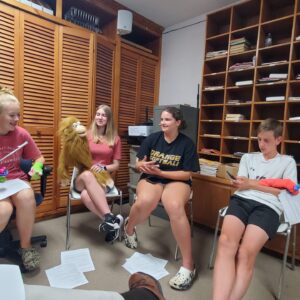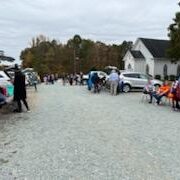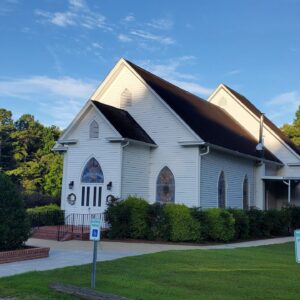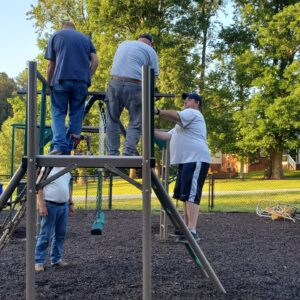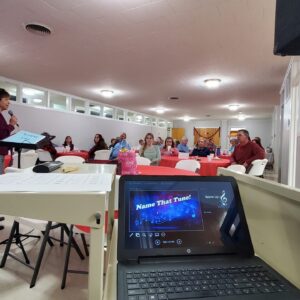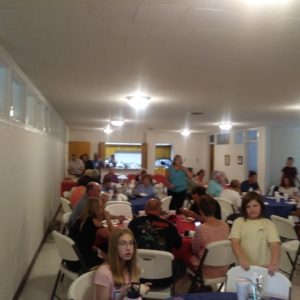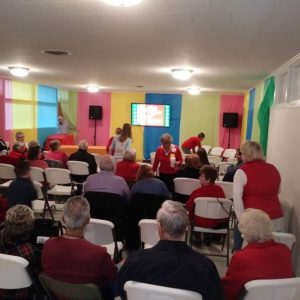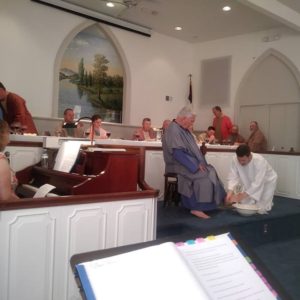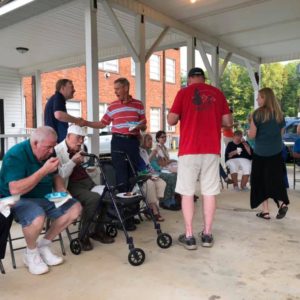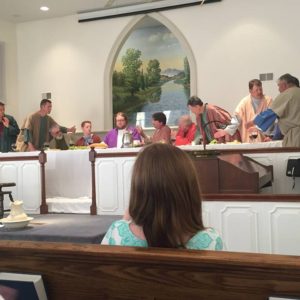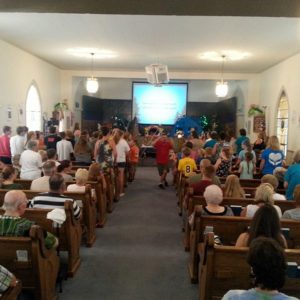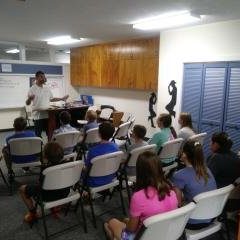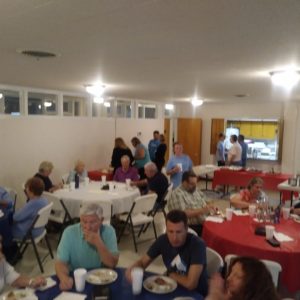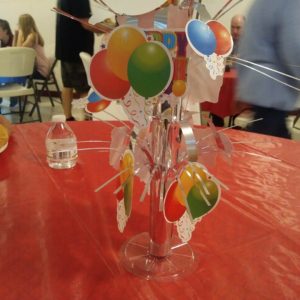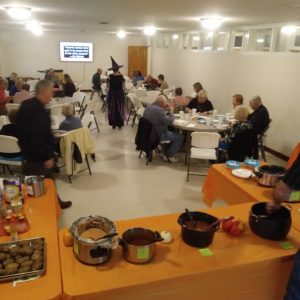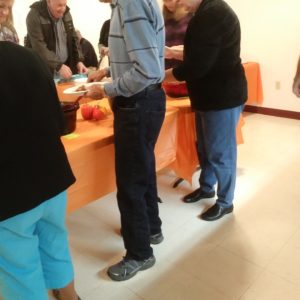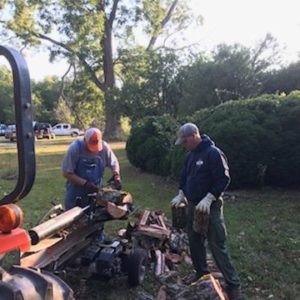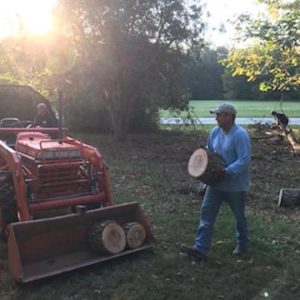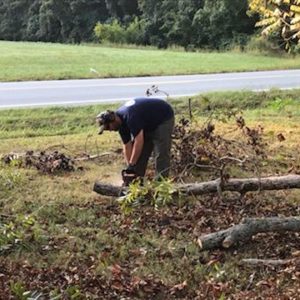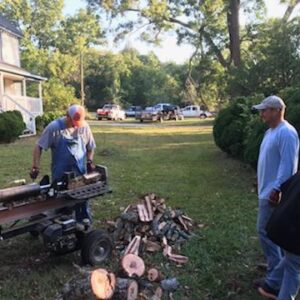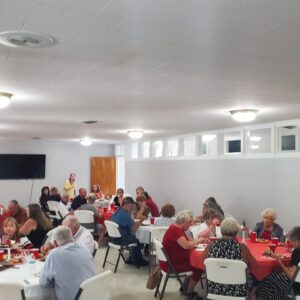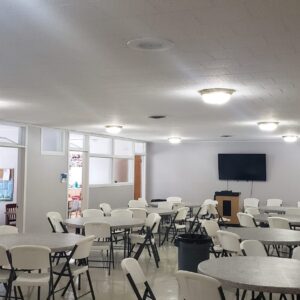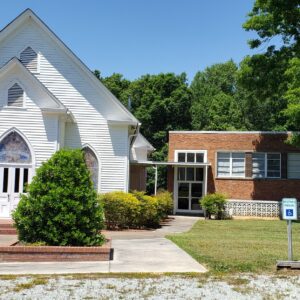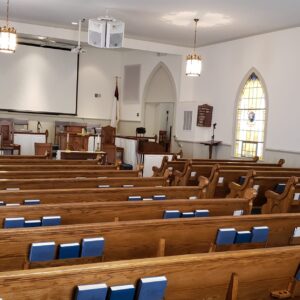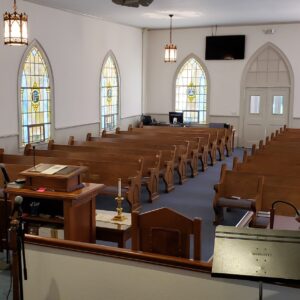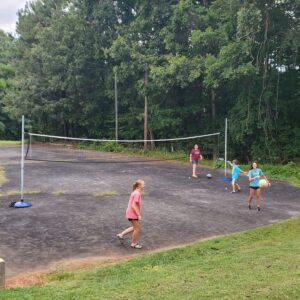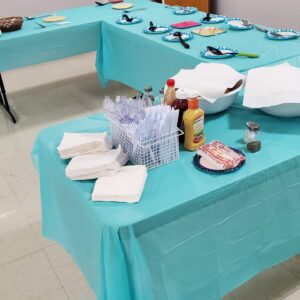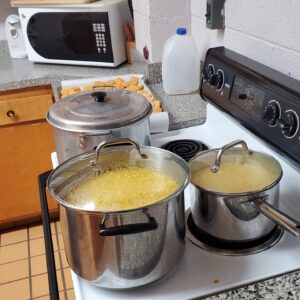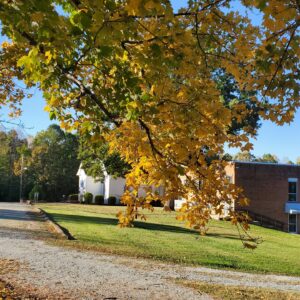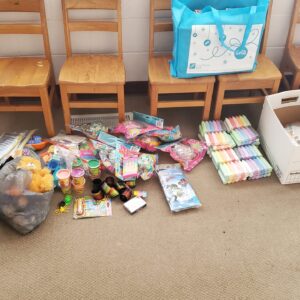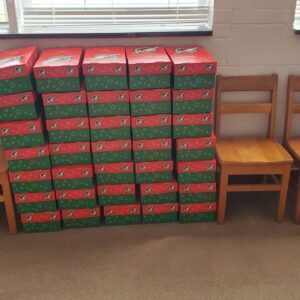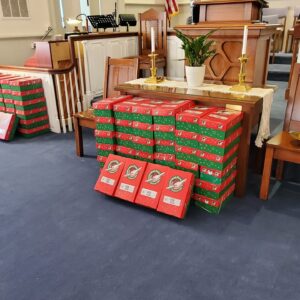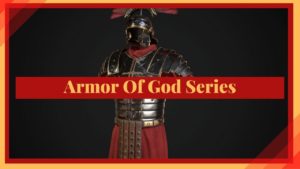Maxine Marie Hawkins Lucas – 14 February, 1924 – 14 March, 2024
Our mothers are our most intimate and fundamental connection in life, literally carrying us inside of them and then giving birth to us and then nurturing us from infancy through life in one way or another, or really in many ways, for as any mother can tell you, once a mother and child relationship exists, a mother is a mother for life, and a child is the child for life. There is no other relationship as fundamental in our lives. That means our mothers are almost by definition great people in most cases. Marie was always a tireless and never-ending positive force in the lives of her children and family – and always a relentlessly driving force for good in the world. Marie was quietly a great person from the start, even as a child.
Marie Hawkins Lucas was born a Valentine’s Day baby, and she was indeed a great gift of love not only to her parents and her family, but also to her community and to the world. She was one of what eventually grew to be a big farm family of 11 brothers and sisters and 2 half-brothers and a half-sister. She was the family’s new baby, but not for long. Her sister Edith was born around the time Marie was one year old. As such, the family wondered if Marie would even survive, because the nourishment and attention she needed as the baby was now needed by the newest baby. Her family even thought for a time that she might die for lack of sufficient nourishment, but at present, she is the first and only one of her siblings to live to the age of 100 years, a testament to her stubborn, feisty nature. When she was small, her family used to sometimes call her “String Bean” or “Splinter” because she was so skinny, and she never liked those names. She had to learn to have an attitude of fighting and steeling her own resolve to survive and get the physical, mental, and spiritual nourishment she knew she needed to thrive, making her own way in life with her feisty, independent spirit. Born a part of that so-called “Greatest Generation” which in turn survived the Great Depression, World War II, the Cold War threats of nuclear holocaust and annihilation and the social conformity which was often the fearful response to such threats, as well as the turbulence of necessary changes in our society as the American Dream realized that it needed to be always more diligent in striving to make itself more true to its ideals, striving to reach a more benevolent hand to its own as it fought to figure out its place in a Cold War world, and simultaneously reached for the Moon and stars. Personally, Marie was what we always like to picture as quintessentially American in that sense, believing strongly in freedom and independence, and personal freedom of choice, and the personal responsibility that comes with that personal freedom. Those were not just words for her – they were true ideals, but ones which one tries to live by and to use to make both one’s self and one’s society better, for we as a society are ultimately a collection of individuals who seek to find common purpose and ways to better ourselves to rise beyond the rightly revered aspects of our shared history as well as its faults and foibles, its shortcomings and its great triumphs, to find the better selves in us all. Marie loved to read, but not only for amusement. She often could be found reading books on self-improvement of various kinds late at night after everyone else had given in to sleepiness and had gone to bed. She always believed that she as an individual and we as a country and indeed a wider world of humanity were forever unfinished works in progress, forever needing more work and attention to the details of self-improvement. Just as she always believed that a country could always examine itself and become better and more true to its ideals, she also believed in such things for our personal lives, as well. She seemed to believe that the unexamined life and the unacknowledged and unexamined history was not the way to go, for both countries and individuals, because to improve, you always have to start by admitting your faults and then working to overcome them. She believed that it was not the easy way, but that it was the right way. It was only by such self-examination and willful determination to solve difficult problems which often had no easy answers and which often required some hard measures of self-sacrifice to improve the world around them that such great things were achieved by this “Greatest Generation”. As President Kennedy said about the goal of the US Mercury, Gemini, and Apollo space programs and eventual moon landings a decade later, “We choose not to do these things because they are easy, but because they are hard.” Greatness always demands that one has great challenges, whether as a nation or an individual, or even the human race as a species, and we have always had great challenges, as we still do to this day. As a hallmark of this, Marie always believed that with great rights and the gift of great opportunities come great responsibilities. You don’t get one without incurring the other. Marie loved humanity, and she loved passionately, fiercely. You can see it in her eyes and in the beautiful determination on her face in her high school portrait at the age of her mid-to-late teens. She wanted to make the world a better place, and to leave things better than she found them. She sometimes quietly and sometimes more vocally lived with love and passion for what she passionately believed to be right. As such, she took the words of the Bible and Jesus to heart – that however one does to and for those considered the least of our society, thus one also does towards the omniscient, omnipotent Deity, and she believed that love for our fellow humankind, if followed as truly directed, is one of the most revolutionary acts that one could undertake. Beyond her obvious physical beauty was her natural intelligence and wit, her ever-present spiritual strength, and her will to enact a greater love for humankind and to do good and be a force for good in the world. She truly believed in the maxim that Love in its greatest, best, and purest forms is the ultimate answer to the ills of the world, backed up by a will to live by the Golden Rule – “Do unto others as you would have them do unto you.” In that sense, Marie was the very definition of “the iron behind the velvet”, a physical beauty, but also one with an iron will which she always used for good, and in defense of those who were more unfortunate and downtrodden or facing troubles which seemed insurmountable. For a short time after high school, Marie worked at a factory in Mebane, North Carolina. She had also gone to places like Silver Spring, Maryland with several of her sisters of similar age, to see the sights there and in Washington, D.C. – they made quite a striking sight walking along as 4 beautiful sisters captured in a photograph from those days. Although her own economic circumstances made it more difficult to pursue one of her dreams – to attend UNC to become a social worker, she always had the benevolent impulse of helping others. College was expensive, however, so instead, she eventually followed a route that was more practical and affordable for her – attending the Watts Hospital School of Nursing after high school and graduating as a Licensed Practical Nurse, with subsequent employment at Watts Hospital, where she could enact her will towards the higher love and goodness by caring for patients. During those years, when not as many women worked outside of the home as more men returned from WWII, she braved drives by herself on sometimes icy and snowy winter roads which were icier and snowier and not in as good condition as they are today. She worked at Watts Hospital until her first child was born, but she felt that she needed to be a full-time mother after that, given the importance of early childhood experiences for babies and young children, when she felt that the raising and education of any children she had was an even higher, more personal calling which demanded all that she could give to it. So, she became a mother and housewife at that point, but she was always reading, studying, and later, once they had a television, watching UNC Educational TV (forerunner of PBS) trying to learn as much as she could about anything which captured her interest and seemed worthwhile knowledge to her.
Marie’s sense of spirituality was full of Nature more than mere religiosity and public show. Her sense of spirituality and faith was a deep well and reservoir which she drew upon almost as routinely as breathing, and it was a deeply individual and private view which she held. However, she was also very engaged with the idea of spiritual community because humans are social creatures and just as John Donne said, the individual is not an island. She had attended Walnut Grove United Methodist Church as a child, alongside the road, Hawkins Road, which is named for her family. Later, after marriage, she attended Mars Hill Baptist Church, the church her husband and his family had attended, and became a long-time member there.
Marie was fascinated by the great outdoors and the natural world around her. Growing up on a farm, and being one of the older children in a very large farm family, she was often called upon by her mother and father to take on many chores for the family – cooking and cleaning and the like, not what she most wanted to do, but what they needed her to do. Marie did what she could and what she needed to do despite her sometimes feisty personality, but her natural spiritual refreshment from these tasks was to find solace in the outdoors – sunshine, rain or snow, she loved it all – and in her love of flowers and vegetables and trees and other plants as well as animals, and a love of gardening in general. She was never happier than when her hands were in the dirt, first planting, then watering, then weeding (yes, even that!), and then finally harvesting and sharing the sweet and savory fruits of the Earth and of her diligent labors with others around her. After marrying Walter Lucas on December 30th, 1947, she moved to another farm, a bit closer to town, but still out in the country, and with 60 beautiful acres of rolling hills and varied landscapes, a place that she came to love as her own. At the height of her growing things on her own farm, she and her husband’s parents had 3 or 4 large garden plots every year, along with two orchards, a cultivated grapevine, and wild grapes perfuming the air around the trees in the forest in whose branches they grew, and they made good use of all that bounty, both by consuming fresh vegetables and sharing the rest, and by canning to preserve for leaner times when those items would be out of season. She lived with her husband and his family in their home from her marriage late in 1947 until 1955 when they built a new home and moved into it. She came to know and love the farm so well on her walks through the pastures and woods that for the rest of her time living there, as long as she was able to walk, she could tell you where any group of wildflowers or flowers she had planted were growing and blooming. She always reveled in both flowers like roses, which she dearly loved, as well as daffodils and irises and many others, but she also loved the wildflowers of all sorts that grew everywhere.
Both for the pleasure and the labor of it, she was always happiest when gardening, whether planting or taking care of flowers, or planting gardens both as a means of helping the family budget for feeding the family, or for the simple joys of planting seeds, watering them, watching them grow, and then weeding, and harvesting the fruits of the Earth and of her labors and turning them into wholesome, natural food for dishes she cooked for herself and her family. She always took great pride and joy in that, having 3 or 4 large garden spots, a couple of orchards, and grape vines as well as berry patches on the farm, much like the berry patches on her parents’ farm where she picked berries as a girl.
She liked listening to and watching the NC State Agricultural Extension agents’ advice programs on the radio and TV, and reading cookbooks and watching UNC-TV cooking shows about food and cooking around the world. Even at the age of 92 or 93, during her last year living at home, she was resolute in her will to have a garden – at least a small one, and she enlisted both of her sons in that effort, and she was very proud of the results, and enjoyed them greatly.
Marie’s love of Nature and the natural world extended to many other things. She loved animals, enjoying the sight and interactions with cows and horses and dogs and cats and other creatures on the farms on which she lived as a child and as an adult. She loved talking to them with a soothing voice which they understood to be gentle and appreciative of their own nature. Marie was like that with people, too, as much as she could be. Even when in disagreement with others, she sought to make sure that they knew that it was loving disagreement. She enjoyed telling her children old sayings from her elders about the weather – saying things like that when it warmed more than usual in the Winter and frogs were heard singing, they would soon be singing under ice. She also enjoyed showing her children tadpoles in the little wet-weather streams on the farm in the Spring, and the metamorphosis of transformation of caterpillars to butterflies and moths. Similarly, she loved the sight and sounds of the many different birds and insects and other wildlife that could be seen and heard on and around the farm – the sight of cardinals and bluejays, robins, brown thrushes, and mockingbirds, and at night, the cries of owls and the distinctive, lonesome-sounding, back-and-forth calls of nearby and more distant whippoorwills. She even bought a child’s book for her children about the sounds of the night – the chirping of crickets and the calls of tree frogs and bull frogs, and the almost incessant, overlapping, frictional calls of the chorus of katydids. She loved the changing colors of the leaves of Autumn, even having some table coasters in the shapes and colors of Summer and Autumn maple leaves – green, gold, orange, fiery red, and brown – which her children found to be beautiful playthings and adornments on the table. She had some bamboo cups which were decorated with simple Asian-style designs of bamboo leaves and branches, more artistic relations to the natural world all around. She loved the sun – the pale, but colorful hues of dawn and disk, the rich, golden light of early morning and late afternoon, and the bright light of noon, but she absolutely loved the moon. Even not long before she died, if outside, she would often comment in artist’s colorful terms about the many varied colors of the sunset, or she would find the beauty in the clouds drifting overhead in a blue sky, and even in the daytime, she would spot the moon in the sky when present, and point it out to those with her. She loved the transformative power of sunlight and moonlight on the landscape, and also the faint features of nocturnal views only lit by starlight, a prime benefit of living in the country, though more eroded by bright night lights from nearby towns and houses nowadays than was once the case. She loved the stars, too, and appreciated them both artistically and emotionally, and rationally, for what they actually are, giant, distant, burning balls of gas. Such wonders of both art and science in Nature made deep impressions on Marie, and she shared those with her children and others around her. It was as wondrous to know what something actually was as to know how it looked, and what the implications of that existence were, and what could be learned from it. She never really lost touch with her inner child that was so crucial to learning and a desire to learn, and speaking of children, Marie always loved babies, and found them endlessly fascinating to watch and interact with…
She saw the world, and indeed the Universe, with an artist’s eyes, but she also appreciated the science of it.
Marie loved and was interested in cultures of the world and in music, art, and science.
When it came to music, her father played the fiddle and the banjo, and she loved to sing, whether singing alone around the house or outdoors on the farm, or singing with her sisters, or singing hymns with a congregation at church. Her father also had the first radio in the area when she was a child, and he used to sometimes turn the volume up full so that they could hear the music and songs of the Carter Family floating down across the lawn to the meadow below the house where they would be working outside. Much later, in her eighties, she got to twice visit the Carter Family Fold in southwestern Virginia and she got to sit in Johnny Cash’s rocking chair. She also visited the Blue Ridge Music Center near Galax, Virginia, and the Birthplace of Country Music Museum in Bristol, Virginia where she got to see more of the history of the music she had loved on the radio as a child. Perhaps as a nod to her sister-in-law Maude, she enjoyed listening to Metropolitan Opera broadcasts. She also enjoyed her brother Fred’s piano playing. One day, a young, tall, skinny guy she had seen driving up and down the road before stopped to give her a lift when she was walking along the road as he passed by and then came back, and though cautious at first as any young woman would be even in those days,, she met Walter Lucas, a young man who had also played guitar on the radio in Durham, NC, the man she would later marry. Their first son was named for a Big Band leader whose music they enjoyed. Both of them always tried to impart their love and enjoyment of music to their children, and music of all sorts, from the Big Band sounds and jazz of their day to old-time and bluegrass fiddle tunes, twin-fiddle Western Swing, old hymns, classical music, and international music of various kinds, they grew a love of music that had no borders and which in later years, even they sometimes forgot that they had inspired when asking where one had gotten a love for this or that kind of music. They had music of all kinds playing in the house from time to time, and they had not only had record collections of old 78s of that variety of music, but they also bought recordings of collections of music of various kinds – classical, opera, folk, etc. – for their children to hear. When a local grocery store offered them, Marie came home with LP album recordings of classical pieces like Dvorak’s “Symphony From the New World” and Tchaikovsky’s Piano Concerto Number 1. All of these kinds of music and more made big impressions on their children and were a part of their almost organic musical education. Marie and her husband Walter instinctively knew that being in a home surrounded by music and musical instruments, in a home where music was both listened to and played, was an enriching and pleasurable social experience not only for themselves, but for those children. Often at Marie’s instigation, they also took their children to things like outdoor concerts by the university symphony or student ensembles at places like the Ancient Greek-style Forest Theater at UNC or at places like Duke Gardens, where you might find the student musicians barefoot and in t-shirts and jeans as they played Bach, Handel, Haydn, Mozart, Beethoven, and Schubert, or to organ concerts or sometimes organ with symphony and chorus at Duke University Chapel where you could not only hear the music, but also feel the rumble of the organ’s powerful bass tones via the stone pavement of the floor and wooden pews, and the soles of your feet and the seat of your pants. They took them to Big Band concerts at the local schools, inspiring their older son to join the school band in junior high and play the trombone in the high school band and some All-State bands, and to Marie’s family’s big outdoor fish fry dinners that often revolved around some farm work but which also often involved music of some kind. Marie and Walter encouraged their older son’s interest in music and musical instruments when as a small child, they gave him a small toy guitar, and a small toy violin, and a small toy drum, and then later, when they indulged both his as well as Marie’s interest in the piano by buying an old upright player piano, having its finish restored and the guts of it ripped out and converted to a regular piano. In later years, Marie also found an old church harmonium or pump organ that was put together with pegs and had a bellows and reeds to produce the sound. She took it apart, stripped it of its old gummed-up finish down to the natural wood, and then put it back together so that it could be played, although restoring the bellows and some of the reeds was still an on-going project that she pursued when she could. Marie also had a book about Stradivarius violins from the International Violin Company in Baltimore, and when her older sun moved there, she urged him to contact them. Today, he knows and is friends with and has played music with some of the musicians who run that company. He was also fortunate to go to some of the places and hear music in some of the places she loved from the movies such as Salzburg, Austria and The Sound of Music and Mozart, to Prague, which is so associated with Mozart and Dvorak and Smetana, and to Venice which is so associated with Vivaldi and Boccherini, to the Andalusian music of Spain in Granada, French music from various parts of France, English music in England, and of course, Irish and Scottish music in Ireland and Scotland, Andean and Latin music in South America, and to even get to play with other musicians in a number of those places, as well as at home in North Carolina, Baltimore, Texas, California, Hawai’I, Nova Scotia, and various other places around the US and Canada. At the core and behind so much of this was Marie, always a prime influencer, even in the days before that term became popular.
As well as music, she also loved visual arts, and she was very talented at drawing and things like calligraphy. Only 10-15 years or so after the end of World War II, one of the programs she liked to watch on UNC-TV was a program on Japanese calligraphy which featured a master writing the characters and explaining the origins and meanings of them, artistically using an ink brush very gracefully, while accompanied by Japanese musicians playing the koto, shakuhachi, and shamisen. In watching and enjoying that program and encouraging her children to watch it and to try doing the calligraphy herself with them, she also was teaching her children the value of other cultures and their various ways of artistic expression. This later led one of her children to invent a two-layered code using Japanese characters to represent numbers which related to Roman letters which spelled out words in English. It was child’s play, and not an unbreakable code, but though it would have seemed gibberish to a Japanese reader or anyone else, it served the child’s purpose of enjoying writing secret messages to his friends. She loved drawing and was good at it, and she also was an avid photographer who enjoyed practicing her skills at photographic composition. Similarly, her admiration for the figure, portrait, and landscape works of old masters from the Medieval, Renaissance, Baroque, Classical, and Impressionist eras and her active practice of exercising her own considerable talents in looking at the world and drawing what she saw and her eye for photography later also helped her inspire her children and inspired one of them to indulge his interest and talent for drawing and both of them to love photography. She also had a real interest in weaving to the point of getting a hand loom and using it, and she attended a young women’s weaving group and had interactions with the young women of the Duke and UNC communities in Durham and Chapel Hill who were into it. Her love of drawing persisted into older age for as long as she could do it. One would not know it, necessarily, but the mirror-imaged lilies on the upper corners of her and her husband’s tombstone are her hand-drawn reproductions of Leonardo da Vinci’s drawings of lilies from the 1400s cut into the stone. Now you know and can think of that fact, if you remember it, if you ever find yourself standing in front of her tombstone.
As mentioned earlier, Marie loved reading. Marie oved old books and old book stores. She partlcularly loved frequently visiting The Intimate Bookshop in Chapel Hill, and another bookstore that specialized in old books – The Old Book Corner. When reading literary fiction rather than reading for self-improvement or for non-fictional interests in history, culture, arts and crafts, Nature and science or other topics of interest, books like Little Women, and Lucy Maude Montgomery’s Anne of Green Gables were some of her lifelong favorites, as she felt a natural kinship of spirit with their feisty female heroines. She never got to visit Nova Scotia, though she always wanted to visit there, and she was very happy when one of her sons did, and when he also visited Lucy Maude Montgomery’s home on Prince Edward Island and brought her back some souvenirs of both places, as well as souvenirs from Salzburg, Austria which she had loved on film in The Sound of Music, and various other places from literature and video which inspired her. She also liked Shakespeare’s plays for reading and on the stage or on video. An early memory was of watching a Shakespeare play, Macbeth, as an early black and white video, and the cleverness of the portrayal of medieval soldiers carrying small pine trees as the prophetic occurrence of Great Birnam Wood coming to the hill of the battle of Dunsinane being a memorable sight, as well as watching a similar documentary video with her on UNC-TV about the 1746 Battle of Culloden in Scotland and the end of Bonnie Prince Charlie’s Highland Jacobite rebellion.
Marie loved architecture and history. Multiple trips to places in NC, TN, VA, MD, PA helped give her children more of a sense of history and its complexities. She signed her older child up for a science experiment on childrens’ play and sleep and brain waves at Duke University when he was a child, allowing him to play and sleep while electrodes were attached to his head and his brain waves were being recorded on a paper strip chart recorder, and remembering that experience and how he got to talk with the scientist who explained things to him and seeing a copy of that recording they were allowed to take home helped to stimulate his own interest in science as he grew.
She appreciated and indulged her childrens’ interest in cars, trains, boats, airplanes, and rockets being launched into space, and the people who designed and used them as vehicles for travel and exploration. There are fond memories of watching many rocket launches and space missions, and astronauts space-walking and walking on the moon on TV as children. That willingness to indulge and support their interests in such things helped feed their own interest in and love of such things as explorations of ones’ surroundings and of the Earth and the Universe. This later enabled her to meet and mingle and converse with some of the foremost of those who do such things.
Marie took great and vicarious pleasure in the various adventures of her sons, both local and far-flung, and she loved their accomplishments, but she was also quite capable of reminding them that they also had plenty of good reasons to be modest, for we are all far from perfect, and we all have plenty of room for improvement of all sorts, and we are all the beneficiaries of good fortune when we get to do some of these things and go to these various interesting or beautiful places.
In addition to all of these general stellar qualities of Marie, a few particular vignettes very typical of her come to mind:
- At the age of 85, Marie journeyed to Savannah, Georgia where she saw the Eighth Air Force Museum, and thence to St. Augustine, Florida where she saw the old Spanish 16th-Century city and the 17th-Century fortifications of the Castillo de San Marcos, and then to Cape Canaveral, where as a family member of someone involved in a space shuttle mission, she toured the facilities new and old, meeting veterans of many NASA launches there, plus seeing the unusual sight of two space shuttles on a launch pad at the same time, and finally getting to see a space shuttle launch there from a VIP area. As part of the same space shuttle Hubble Space Telescope servicing mission, Marie twice got to meet the astronaut crew, first at a picnic with the astronauts on the Goddard Space Flight Center grounds, and later at a “meet and greet” reception at the Space Telescope Science Institute. She was thrilled when the shuttle mission commander, Scott Altman, saw her and immediately said “Hey, I remember you from the picnic!” He had flown some of the Navy jets in the original Tom Cruise movie “Top Gun”, but she had never seen that. She was just impressed that the shuttle commander had remembered her. Six years later, when she could not attend the Hubble 25th anniversary celebrations, he still wrote a nice note to Marie. She also met the only young woman on the crew, an oceanographer, Megan McArthur, who operated the Canadarm (the remote manipulation arm made in Canada) and who grappled the Hubble Space Telescope to place it in the shuttle cargo bay for servicing and then release it some days later when the work was finished. Marie said to her “You sure are a brave young woman to go up there in space with all those old men!” Megan McArthur looked surprised for a second, and then she laughed a laugh of recognition, saying, “Yes, there were some sights and sounds and smells I could have done without…” She and Marie had a good “girl’s laugh” over that, and when her son Ray said “Mom, she rides a rocket sitting on top of highly explosive liquid and solid propellent going into space at 17,500 miles per hour and you think she’s brave because she went up there with a bunch of men?!” But again, she and Megan knew what they were talking about, and they both had another laugh from their “girl’s perspective”… She still remembered Marie at functions at NASA Headquarters and the National Air & Space Museum in Washington, DC and asked how she was doing.
- Marie journeyed multiple times with her sons at the age of ~82 and 84 to visit the Pisgah Astronomical Research Institute, or PARI, an old NASA Deep Space Network group of communications dishes in the Blue Ridge Mountains near Rosman, North Carolina which had transmitted Neil Armstrong’s voice from the moon back in the day, and which had later been taken over in various turns by the Forest Service and then the Defense Department and then the Forest Service again, before being transferred by act of Congress to a non-profit educational corporation which converted the big radio antennas to radio telescopes and the biggest pair of them to an interferometric radio telescope. On one of those trips, when her older son was asked to give a talk dedicating some equipment he and others had once used at the Space Telescope Science Institute, she met one of his favorite former UNC astronomy professors who was on the Advisory Board of PARI, and they had a great time talking about their respective apple orchards and their favorite varieties of apples which they each raised.
- At the age of 93, Marie went to see the Total Solar eclipse in 2017 in the Smoky Mountains at Andrews, NC, after having broken her first hip and having learned to walk again with a walker. It was on the 100th birthday of her sister-in-law Ruth Penland Lucas, and in an area where she had grown up. Marie also went to the Cherokee Museum in Cherokee, NC, and traveled the Blue Ridge Parkway over its highest elevation on that same trip, and then at the end of that same trip, she also went to the top of Mount Mitchell again – a popular site to visit from her children’s childhood to her and her husband’s old age and a place where they took their children and then where their children took her and her husband both as elderly adults in later years – and then to a nice late lunch at the restaurant below, watching the sunset on the flanks of Mt. Mitchell, and finally the glow of the orange sunset over it and the Black Mountains in the descending darkness as they drove northwards on the Blue Ridge Parkway. It was an epic trip to see an incredible sight of Nature. Her sons wish she could have been able to make a similar trip at the age of 100 to see the total solar eclipse of April 2024, but it was just not to be, so they are doubly grateful that she got such a great view of the total solar eclipse of August 2017. It still demonstrated her intrepid nature to go see such a sight with her sons as she had recovered from her first broken hip and was dealing with the effects of Alzheimer’s.
- Once, atthe age of about her mid-eighties, she was with her sons on the Blue Ridge Parkway one cold Autumn day in northwestern North Carolina. They stopped near the old pioneer cabin known as the Brinegar Cabin and were having a look around the area in the gathering chilly late afternoon sunset and then shadows of twilight, and after getting cold and hungry enough, both agreed with Marie when she said “I wish there was a restaurant around here.” The Blue Ridge Parkway is notably devoid of such things for most of its length except for a few places. The family had been in that area of the Parkway before, but didn’t remember details of what was there, but it had been quite some time, and so it was with great surprise that, no sooner had Marie spoken those words than around the next turn there was a small, older restaurant, just when and where it was needed! That sort of thing was surprising, but not always so with Marie.
- At age 61, she suffered a broken wrist during a fall while in Baltimore, and at age 69 or so, she suffered a broken heel when she missed a step while climbing down a ladder out of the top of an apple tree. At age 69, along with her husband and younger son, she was in a very bad auto accident which was not their fault, and in which her leg was badly bruised and her ribs broken and her sternum cracked so that the right side of her rib cage slid under the left side and bruised her heart. In her last 18 years, she was diagnosed with Atrial Fibrillation in 2006, went to a space shuttle launch and met astronauts twice in 2009, had a major hernia and surgical repair after dragging heavy logs through the woods after that, was diagnosed with Alzheimer’s in 2016 when she began exhibiting symptoms at age 92, broke her first hip at age 92, learned to walk again after surgical repair of the hip, went to view the total eclipse of the sun in 2017 at age 93, broke her second hip at age 94 and had it surgically repaired, had her tibia and fibula accidentally broken by a nursing assistant and had her leg in a cast for 6 months, had pneumonia 2 or 3 times (she had also had double pneumonia as a child), and survived 3 bouts of Covid, the first two seemingly asymptomatic, but the third being something that came at an older age, perhaps was yet another genetic variation, and one that seemed to drain her energy and hold on to her and was harder to shake and overcome than the earlier two bouts, and it seemed to be what may ultimately have taken her from us a month after she celebrated her 100th birthday. Though it had seemed that she might more slowly come back from the ravages of Covid and dementia, it was still felt that she might perhaps come back much as she had before, and she had begun to seem as if she might, and she might even keep going to 101 or more, but then something suddenly happened, and she could no longer seem to eat or drink or swallow or speak, and at that point, the end came very quickly. Looking back at all of this, it seems amazing that Marie lived to reach and exceed her 100th birthday, and given that, it also seems plausible that Marie could easily have lived on and remained active for a few more years well beyond the age of 100, especially after the way she had fought and overcome so many challenges in her last 15-18 years.
- A feisty fighter from early on, in order to not only survive but also thrive, she was also always a fighter who gave it her all. That is probably why her ending was so relatively sudden after her having seemed and been so strong for so long. Like a soldier fighting against overwhelming odds while running low on ammunition, she daily fought for the continued establishment of her freedom and independence in various ways until the end, when she had no more strength for her ammunition and finally just simply had no more energy for the fight left in her. If she wanted to do something, she was always very determined, and if she didn’t want to do something, she was very stubborn and you couldn’t make her do it. She never surrendered, but simply was finally taken from us when there was no energy or resources left with which to fight. She will always be fondly remembered with love and respect and she will always be sorely missed.
If there are a few more bits of symbolism we would highlight here in closing, it would be these… The light of her irrepressible spirit still shone in her sparkling eyes no matter what her age, and we will always admire that… it is particularly fitting that as she passed, the Earth was already sending up flowers – hyacinths that she had given as gifts for planting, daffodils, and tiny dwarf irises, and many trees were already beginning to bloom with the blossoms of the impending Spring – symbols of rebirth and new life that she loved so dearly and which gave her such pleasure. Though already having trouble, e day before she passed, she was out in the warmth of the bright sun under a brilliant, blue sky for about 2 and a half hours. The night before she passed, her last night alive on the Earth, Jupiter and the crescent moon lying on its back near it, made a spectacularly fitting sight, and on her last day, the sun still shone brightly, just as her spirit shone on all around her. May she forever rest in peace and beauty among the celestial flowers of Heaven..

